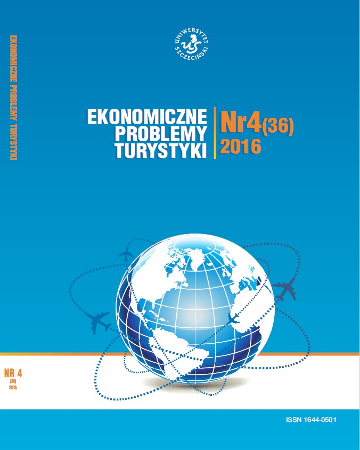
ISSN: 1644-0501
eISSN: 2353-3188
OAI
DOI: 10.18276/ept.2018.1.41-04



Issue archive /
nr 1 (41) 2018
Ekonomiczny wymiar bezpieczeństwa pracy - szacunek utraconej produktywności w polskim sektorze turystycznym
(Economic Dimension of Occupational Safety - The Estimation of Lost Productivity in The Polish Tourism Sector)
| Authors: |
Agnieszka
Jakubowska
Politechnika Koszalińska |
| Keywords: | lost productivity occupational safety tourism sector |
| Data publikacji całości: | 2018-04-27 |
| Page range: | 10 (41-50) |
Abstract
The subject of the study was to assess the level of lost productivity of human resources in the tourism sector in Poland as a result of working conditions. The economic consequences of accidents at work in this sector have been determined. Estimation of the cost of lost productivity was based on “human capital approach”. Depending on the valuation criterion applied, the estimated lost productivity per 1000 employed in Section I was between 39 and 43% of the average value in the economy. The results showed the link between the health and productivity observed in the tourism sector. They can also serve as a basis for discussing the costeffectiveness of “health” interventions from the perspective of the employer and the health sector.
Download file
Article file
Bibliography
| 1. | Bloom, D.E., Canning, D., Sevilla, J. (2004). The effect of health on economic growth: a production function approach. |
| 2. | World Development, 32 (1). |
| 3. | Chapman, L.S. (2012). Meta-evaluation of worksite health promotion economic return studies: 2012 update. American Journal of Health Promotion, 26 (4), 1-12. |
| 4. | Devaux, M., Sassi, F. (2015). The Labour Market Impacts of Obesity, Smoking, Alcohol Use and Related Chronic Diseases. OECD Health Working Paper, 86. |
| 5. | ESENER (2014). Europejskie badania przedsiębiorstw na temat nowych i pojawiających się zagrożeń przeprowadzane. Pobrane z: https://osha.europa.eu/pl/surveys-and-statistics-osh/esener, (10.07.2017). |
| 6. | Eurostat (2017a). Pobrane z: http://ec.europa.eu/eurostat/web/products-datasets/-/hsw_n2_01, (10.07.2017). |
| 7. | Eurostat (2017b). Pobrane z: http://ec.europa.eu/eurostat/web/products-datasets/-/hsw_exp5b, (10.07.2017). |
| 8. | Galama, T. J., Van Kippersluis H. (2013). Health inequalities through the lens of health-capital theory: issues, solutions, and future directions. In: P.R. Dias, O. O’Donnell (eds.), Health and Inequality, pp. 263-284. Bingley: Emerald Group Publishing Limited. |
| 9. | Goryakin, Y., Suhrcke, M. (2017). The impact of poor adult health on labor supply in the Russian Federation. The European Journal of Health Economics, 18 (3), 361-372. |
| 10. | Grossmeier, J., Terry, P.E., Anderson, D.R., Wright, S. (2012). Financial impact of population health management pro¬grams: reevaluating the literature. Population Health Management, 15 (3), 129-134. |
| 11. | Mattke, S., Balakrishnan, A., Bergamo, G., Newberry, S.J. (2007). A review of methods to measure health-related productivity loss. American Journal ofManaged Care 13 (4), 211-217. |
| 12. | Mitchell, R. J., Bates, P. (2011). Measuring Health-Related Productivity Loss. Population Health Management 14 (2), 93-98. |
| 13. | OSHA (2008). Ochrona pracowników sektora hotelarskiego i gastronomicznego. Europejska Agencja Bezpieczeństwa i Zdrowia w Pracy. Pobrane z: https://osha.europa.eu/en/publications, (10.07.2017) |
| 14. | Wrona, W., Hermanowski, T., Golicki, D., Jakubczyk, M., Macioch, T., Goszczyńska, K., Wójcik, R. (2011). Koszty utraconej produktywności w analizach farmakoekonomicznych. Część I. Przegląd systematyczny piśmiennic¬twa. Przegląd Epidemiologiczny, 65, 147-152. |